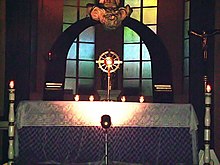Benediction
This article needs additional citations for verification. (August 2008) |
A benediction (
Christianity


From the
A common form of benediction in Baptist and liturgical Protestant churches is for the worship leader to raise his hands and recite the words of the biblical Priestly Blessing (Numbers 6:24-26 KJV). This addition to the
An often complex and lengthy blessing before communion took place in the mass of the Gallican Rite and in some French sees survived until the Gallican rites controversy when they were suppressed. Pope John Paul II, however, gave permission for these sees to restore this traditional element of their local rite.
In the
Benediction of the Blessed Sacrament
One of the most generally popular services in the Roman Catholic Church is Benediction of the Blessed Sacrament, commonly referred to as Benediction and known in France as Salut and in Germany as Segen. It is also the custom of some high-church Anglican churches to hold this service. It is ordinarily an afternoon or evening devotion and consists in the singing of certain
There is a good deal of diversity of usage in different countries with regard to details, but some of the elements are constant. The use of
In English-speaking countries the service generally begins with the entry of the priest and his assistants in procession and with the singing of the "
Judaism
Hinduism
Popularised by ISKCON, benediction in Hinduism usually refers to prayers said or sung sometimes during, before or after lunch, afternoon or any other preferred or chosen time.
In classical music and church music
- The Lord bless you and keep you by Peter C. Lutkin, 1900[5]
- Y'varekh'kha adonai, from Part V of Sacred Service (Avodat Hakodesh) by Ernest Bloch, 1930-1933 [6]
- Opening Prayer, in Hebrew, a setting for baritone and orchestra composed by Leonard Bernstein for the reopening of Carnegie Hall, 1986
- The Lord bless you and keep you by John Rutter, 1981
- A Clare Benediction by John Rutter, 1998
References in popular culture
- "Benediction" is the title of a short story by F. Scott Fitzgerald, published in 1920.
- "Benediction" is a track by Hot Natured and Ali Love, released by the Hot Creations label.
- "Benediction" is the first track on Thurston Moore's solo album Demolished Thoughts.
- "Benediction" is a track on The Weakerthans' third album Reconstruction Site.
- "Benediction" is the title of a novel by Kent Haruf, published in 2013.
- "Benediction" is a track by August Alsina.
- "Benediction" is a Death Metal band from Birmingham, UK.
References
- ^ Precht, Fred L. Lutheran Worship History and Practice. St. Louis: Concordia Publishing House, 1993. p. 434.
- ISBN 9780198029267.
In the 1824 Methodist Episcopal Discipline, instructions for the use of the Lord's Prayer and the apostolic benediction (2 Corinthians 13:14) were added, with the former to be used "on all occasions of public worship in concluding the first prayer," and the latter at the dismissal.
- ^ "CATHOLIC ENCYCLOPEDIA: Benediction of the Blessed Sacrament".
- ^ "Benedictions". Encyclopedia Judaica. Jerusalem : Encyclopaedia Judaica ; [New York] : Macmillan. v. 4 p. 484.
- ^ "Archived copy" (PDF). Archived from the original (PDF) on 2014-03-29. Retrieved 2019-07-31.
{{cite web}}: CS1 maint: archived copy as title (link) - ^ "Sacred Service (Avodat Hakodesh)".
